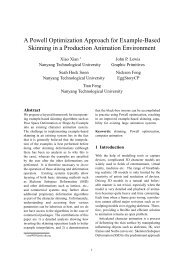Real-Time Weighted Pose-Space Deformation on the GPU
Real-Time Weighted Pose-Space Deformation on the GPU
Real-Time Weighted Pose-Space Deformation on the GPU
You also want an ePaper? Increase the reach of your titles
YUMPU automatically turns print PDFs into web optimized ePapers that Google loves.
T. Rhee, J.P. Lewis, and U. Neumann / EG 2006<br />
5.1. Parallel WPSD<br />
The computati<strong>on</strong> cost of <strong>the</strong> SSD skinning algorithm is<br />
O(n vertex × n joint ) from equati<strong>on</strong>s 1, 2, PSD is O(n vertex ×<br />
n joint × n pose) from equati<strong>on</strong>s 1, 2, 4, and WPSD is<br />
O(n vertex × n joint × n pose × n pose × n pose) from equati<strong>on</strong>s 1,<br />
2, 4, 5, 6. Where, computati<strong>on</strong> cost of original PSD is defined<br />
by equati<strong>on</strong> 1, 2, 4, since r i is same in all vertices and<br />
d i can be pre-calculated.<br />
The number of joints n joint and poses n pose can be reduced<br />
to <strong>the</strong> smaller numbers using <strong>the</strong> method developed by Kry<br />
et al. [KJP02], as will be discussed in secti<strong>on</strong> 5.2.1 with efforts<br />
to reduce texture memory space.<br />
In previous research, <strong>the</strong> Eigenskin method based <strong>on</strong> PSD<br />
was developed using <strong>GPU</strong> vertex programming [KJP02].<br />
The vertex program uses a relatively small number of slow<br />
processing units compared with <strong>the</strong> fragment processors,<br />
and <strong>the</strong> per-vertex computati<strong>on</strong> cost of <strong>the</strong> original PSD<br />
is O(n joint × n pose). Therefore WPSD, having higher pervertex<br />
computati<strong>on</strong> cost O(n joint × n pose × n pose × n pose),<br />
can clearly benefit from parallel computati<strong>on</strong> <strong>on</strong> fragment<br />
processors.<br />
5.2. Parallel WPSD <strong>on</strong> <strong>GPU</strong><br />
We developed parallel skinning using <strong>the</strong> <strong>GPU</strong> fragment<br />
processors and dem<strong>on</strong>strate our method using three rendering<br />
passes. In order to minimize real-time computati<strong>on</strong>, we<br />
separate possible pre-calculati<strong>on</strong> steps and save <strong>the</strong> results<br />
into texture memory using texture maps. Because <strong>the</strong> value<br />
in <strong>the</strong> texture memory is not changed in <strong>the</strong> successive deformati<strong>on</strong>,<br />
it can be pre-computed and stored in <strong>the</strong> read-<strong>on</strong>ly<br />
texture memory.<br />
In <strong>the</strong> first and sec<strong>on</strong>d pass, per-vertex deformati<strong>on</strong> is calculated<br />
in <strong>the</strong> fragment program and <strong>the</strong> results are stored<br />
in texture maps using <strong>the</strong> FBO (Frame Buffer Object) extensi<strong>on</strong><br />
[Gre05]. These texture maps are bound to <strong>the</strong> geometry<br />
of <strong>the</strong> rest pose with <strong>the</strong>ir texture coordinates. In <strong>the</strong> third<br />
pass, each vertex in <strong>the</strong> rest pose is changed by <strong>the</strong> deformed<br />
vertex stored in <strong>the</strong> output texture generated in <strong>the</strong> first and<br />
sec<strong>on</strong>d passes using vertex texture fetch.<br />
5.2.1. Packing data into textures<br />
The fragment processors cannot access vertex informati<strong>on</strong>.<br />
Instead, we can use texture memory to send data to <strong>the</strong> fragment<br />
program. Informati<strong>on</strong> needed in <strong>the</strong> fragment program<br />
is packed into texture maps and stored into texture memory.<br />
Geometry informati<strong>on</strong> from <strong>the</strong> rest pose is stored into<br />
two RGB texture maps, a vertex texture T v and normal texture<br />
T n; each has size n vertex × 3. These textures represent<br />
parameter v 0 in equati<strong>on</strong> 2 and each 3D element (x, y, z) is<br />
stored into <strong>the</strong> (r, g, b) value of a texel [Figure 2].<br />
The joint weights calculated in secti<strong>on</strong> 4 are also stored<br />
Figure 2: Packing data into textures: texture map T i can be<br />
T v,T n,T w1 ,T w2 , and T dj . V(vertex), N(normal), W(weight),<br />
J(joint index), and D(displacement) represent each texel<br />
(RGB(A)) value of <strong>the</strong> related texture. T d c<strong>on</strong>sist of eight T dj<br />
storing displacements of each pose j.<br />
in <strong>the</strong> texture maps. In general, <strong>the</strong> distributi<strong>on</strong> of skinning<br />
effects in an articulated body is local to several joints<br />
[MMT97,KJP02], even in a regi<strong>on</strong> as complicated as a hand.<br />
For example, deformati<strong>on</strong>s arising from <strong>the</strong> PIP (Proximal<br />
Interphalangeal) joint of index finger do not propagate to<br />
<strong>the</strong> o<strong>the</strong>r fingers, and deformati<strong>on</strong> <strong>on</strong> <strong>the</strong> middle phalanx of<br />
index finger is <strong>on</strong>ly affected by <strong>the</strong> movement of PIP and<br />
DIP(Distal phalanx) joints. From this observati<strong>on</strong>, we can<br />
reduce joint weight storage from <strong>the</strong> actual number of joint<br />
n joint to a smaller number of “principal joints” ñ joint selected<br />
by sorting <strong>on</strong> <strong>the</strong> weight value. We threshold ñ joint at four in<br />
our tests with an additi<strong>on</strong>al four elements to hold <strong>the</strong> related<br />
joint index. As a result, we can save <strong>the</strong> joint weights of entire<br />
geometry in two RGBA textures T w1 , T w2 each with size<br />
n vertex × 4(rgba) and store <strong>the</strong> entire informati<strong>on</strong> required<br />
for SSD [equati<strong>on</strong> 2] in four textures T v, T n, T w1 , and T w2 .<br />
The displacement values calculated by equati<strong>on</strong> 3 can be<br />
stored in n pose displacement textures; n pose is <strong>the</strong> number of<br />
sample poses. In case of complex joint structures and a large<br />
DOF model, we need many sample poses to calculate accurate<br />
joint weights and PSD deformati<strong>on</strong>. However, since<br />
<strong>the</strong> joint weights can be pre-calculated, we can reduce <strong>the</strong><br />
number of sample poses needed in real-time PSD computati<strong>on</strong>.<br />
PCA (Principal Comp<strong>on</strong>ent Analysis) of pose space<br />
can yield an orthog<strong>on</strong>al basis called “ Eigendisplacement ”<br />
[KJP02]. If we reduce <strong>the</strong> size of pose space from n pose to<br />
ñ pose “principal poses” (ñ pose < n pose), we can reduce <strong>the</strong><br />
number of displacement textures. In our paper, we set ñ pose<br />
as eight in our experiment and save displacements of all<br />
poses into a RGB texture T d having size n vertex × 8(ñ pose) ×<br />
3(rgb).<br />
Therefore, from <strong>the</strong> two important observati<strong>on</strong>s of “principal<br />
joints” and “principal poses”, <strong>the</strong> original computati<strong>on</strong><br />
c○ The Eurographics Associati<strong>on</strong> and Blackwell Publishing 2006.







